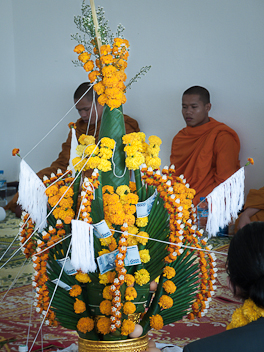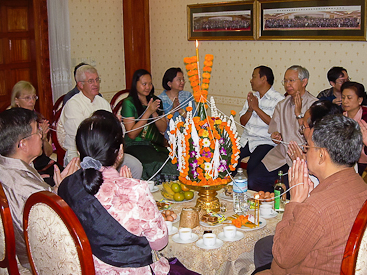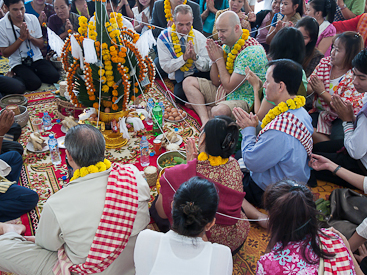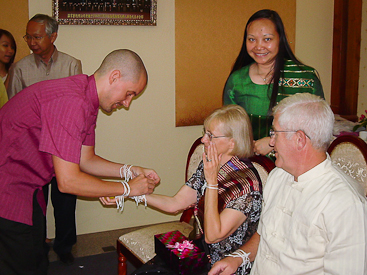Baci Ceremony: The baci is a common, traditional Lao ceremony performed at major life events, including weddings, home comings, house warmings, Pbi Mai Lao, births, welcoming guests, extended illnesses, and the death of family members, among others. The ceremony differs throughout the country, but its basic elements are the same.

The Pha Khuane: The centerpiece in all baci ceremonies is the pha khuane, a flower pyramid. The core of the pyramid, the maak beng, is made of bannana leaves. Onto the maak beng are placed flowers, candles and sticks containing short, white cotton strings. The structure is placed into a silver bowl and set on the floor, surrounded by food items, including boiled eggs, a whole cooked chicken, stickey rice, drinking water, alcoholic beverages, and a mixture of fruits and sweets.


The Ceremony: The guest of honor, for whom the baci is being given, sits closest to the pha khuane while the other guests gather around. After being formally greeted into the room, the mor phon, or master of ceremonies, lights the candles and leads the group in prayer. A string attached to the pha khuane is held by the mor phon, the guest of honor, and the other participants as they pray.

Giving the Blessings: After the mor phon completes his chanting, he removes the short, white cotton strings from the pha khuane and ties one around the wrist of the guest of honor while giving a small blessing. The rest of the participants get in line to do the same. Oftentimes, a knot is placed in the middle of the string to hold the wish being granted. A small bill of money may be tied in the knot or placed in the hand of the guest of honor. Food items may also be placed in the upward turned hand of the guest of honor during the blessing. Strings may also be tied around the wrists of the other participants, as well. Following the tying of the strings, more prayers may be said before everyone eats. The entire ceremony must be complete before it gets dark.
The strings must be kept on the wrist for three days in order for the blessing to come true. After the three days are up, the strings must be untied, as opposed to cut off the wrist. The pha khuane is also kept for a minimum of three days.
Baci Significance: The baci ceremony has been practiced in Laos for hundreds of years. The Lao people believe that the human body is made of thirty-two major organs and that each of these organs has a khuan, or spirit, to protect them. When a person travels a great distance, goes through childbirth, has a death in the family, or any other major life event, the khuane wander away from the body, which can cause illness. The baci is performed to call the khuane back to the body, thereby restoring balance and ensuring good health.

